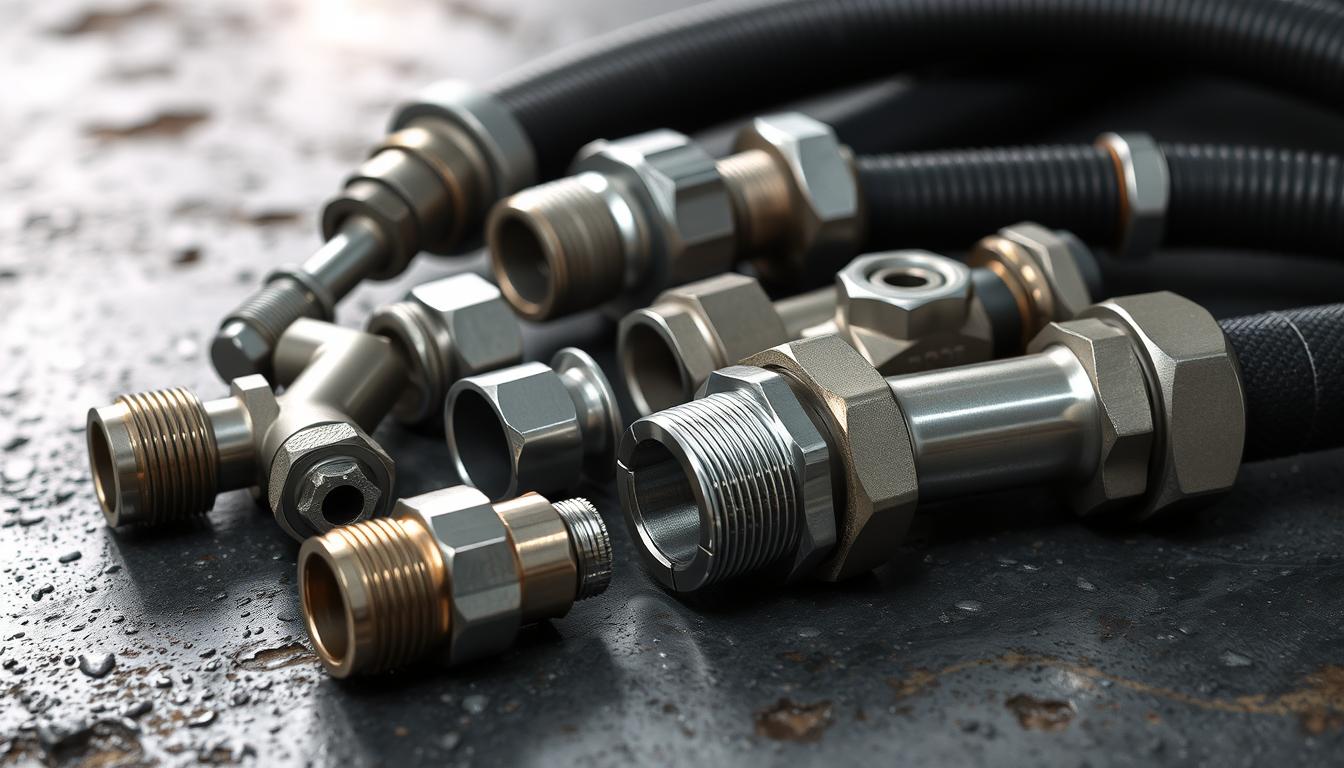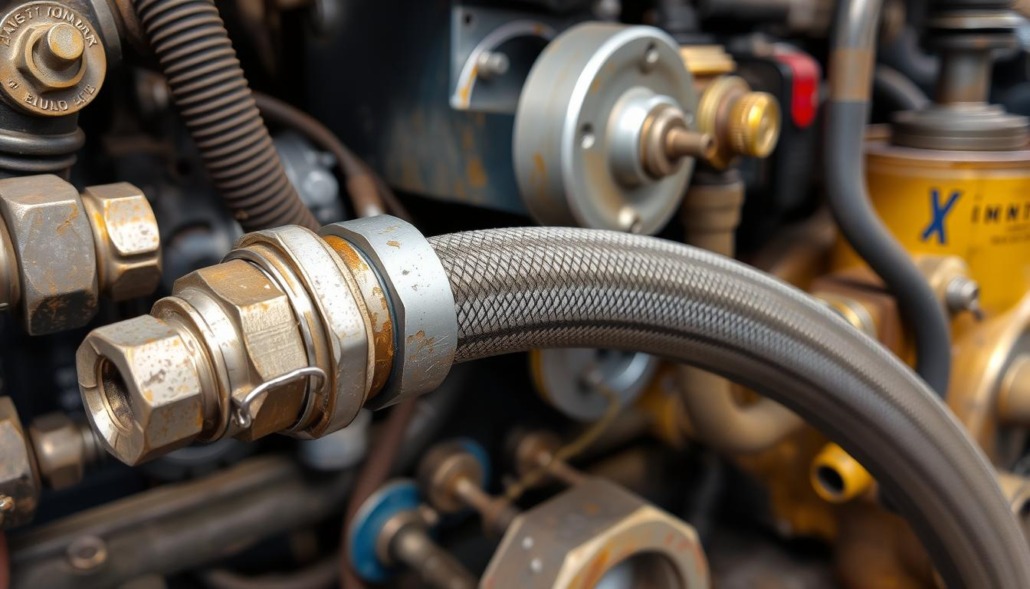Hydraulic hoses are key in fluid power systems. They power many heavy machines and tools in different fields. It’s important to handle and use these hoses right to keep everyone safe and the equipment working well.
This guide will cover all you need to know about using hydraulic hoses. We’ll talk about safety, how to keep them in good shape, and the best ways to use them. This will help them last longer and work better.
Key Takeaways
- Hydraulic hoses are critical for the efficient operation of fluid power systems in heavy machinery and equipment.
- Proper handling and usage of hydraulic hoses are essential for workplace safety, system reliability, and maintenance costs.
- This guide covers essential topics, including safety precautions, maintenance strategies, and best practices for hydraulic hose installation and usage.
- Understanding the different types of hydraulic hose fittings and their applications is crucial for selecting the right components for your specific needs.
- Adhering to manufacturer guidelines and industry standards is key to ensuring the safe and effective use of flexible hydraulic hoses.
Understanding Hydraulic Hose Systems and Components
Hydraulic hoses are key to industrial machinery, moving high-pressure fluids to power many machines. They have three main parts: a strong inner tube, a reinforcement layer, and a protective outer cover. Picking the right hose is vital for your system’s performance and safety.
Types of Hydraulic Hoses and Their Applications
There are many types of hydraulic hoses, each for different uses. Materials like synthetic rubber and thermoplastics affect durability and temperature range. The reinforcement style, such as helical or spiral, also matters for pressure and flexibility.
Essential Components of Hydraulic Systems
Hydraulic systems need more than just hoses. They also need pumps, valves, cylinders, and fittings. Choosing the right fittings, like JIC or ORFS, is key for a tight, leak-free connection.
Hose Construction and Materials
Hydraulic hoses are built to last in tough industrial settings. Knowing about materials and construction helps pick the right hose for your needs.
| Hose Component | Purpose | Common Materials |
|---|---|---|
| Inner Tube | Contacts the hydraulic fluid | Synthetic rubber, thermoplastics, Teflon, silicone |
| Reinforcement Layer | Allows the hose to withstand pressure | Braided, spiraled, or helical designs |
| Outer Cover | Protects the hose from environmental conditions | Synthetic rubber, thermoplastics |
“The right hydraulic hose can make all the difference in the performance and longevity of your equipment. Choosing the correct materials, design, and fittings is essential for maximizing uptime and minimizing costly downtime.”
Safety Precautions Before Handling Hydraulic Hoses
Working with oil-resistant hydraulic hoses, hydraulic brake hoses, and hydraulic suction hoses requires safety. These hoses handle high pressures, extreme temperatures, and heavy wear. Mishandling can cause accidents, damage machines, and lead to costly downtime.
Before you start handling hydraulic hoses, take these safety steps:
- Wear the right personal protective equipment (PPE) like safety goggles, gloves, and clothes. This protects you from fluid sprays or high-pressure hydraulic fluids.
- Make sure the hydraulic system is not pressurized. This prevents sudden pressure releases that can hurt you or damage equipment.
- Check the hoses and connections for wear, damage, or corrosion. The wrong hose or installation can cause it to fail early.
- Clean the hoses and connections to remove dirt. This keeps the system working well.
- Make sure hoses are properly aligned and routed. Avoiding abrasion, twisting, and sharp bends helps them last longer.
- Use the right fittings and connections for a tight seal. This prevents leaks.
- Test the hydraulic system after installation. This finds any leaks or bad connections before it’s used fully.
- Set up a regular maintenance and inspection schedule. This catches problems like wear, abrasion, and leaks early, reducing the risk of sudden failure.
By following these safety steps, you can protect yourself, your equipment, and your work when using hydraulic hoses. Remember, safety with hoses is about using common sense and following the right procedures. This keeps you safe and the system working well.
“Hydraulic hoses are subject to high pressures, extreme temperatures, and heavy wear; mishandling can lead to severe accidents, machine damage, and downtime.”
The National Association of Hose and Accessories Distribution (NAHAD) has named the week of September 10th as Hose Safety Awareness Week. This highlights the need for proper handling and maintenance of hydraulic hoses in industrial settings.
| Safety Tip | Importance |
|---|---|
| Wear appropriate PPE | Protects against fluid sprays or contact with hydraulic fluids under high pressure |
| Depressurize the system | Prevents sudden releases of pressure, which can cause injury or equipment damage |
| Inspect for wear and damage | Identifies defects like cracks, cuts, or abrasions to prevent premature failure |
| Ensure proper hose routing | Avoids abrasion, twisting, and sharp bends, increasing hose longevity and safety |
| Use correct fittings and connections | Prevents leaks and ensures a tight, secure seal |
| Test the system after installation | Identifies leaks or improper connections before full operation |
| Establish a maintenance schedule | Catches issues like wear, abrasion, and leaks early, reducing sudden hose failure risk |
How to Use Hydraulic Hose: Basic Guidelines
Working with heavy-duty hydraulic hose, multi-spiral hydraulic hose, and abrasion-resistant hydraulic hose needs the right steps. It’s key to follow the maker’s rules to keep your systems safe and working well.
Proper Installation Techniques
When you install hydraulic hoses, watch the bend radii and routing tips. Make sure the hoses are the right length to move with the system but not too long. Use separate clamps to stop wear and tear. Also, keep the hoses away from vibrations and other parts to avoid damage.
Connection and Disconnection Procedures
Connecting and taking apart hydraulic hoses needs care and the right tools. Use the right torque for fittings to make sure they’re tight. When taking apart, do it slowly to avoid spills. Always use the right tools to avoid damaging the hose or fittings.
Pressure Testing and System Checks
Before you start using a hydraulic system, do a full pressure test and check. This finds any problems like leaks or blockages early. Follow the maker’s guide for testing and checks to keep your hoses and parts safe and working right.
| Key Hydraulic Hose Installation Considerations | Benefits |
|---|---|
| Maintain Recommended Bend Radii | Prevents hose collapse, flow restriction, and damage |
| Provide Adequate Hose Length | Accommodates expansion/contraction and reduces stress |
| Implement Proper Clamping and Routing | Prevents abrasion and extends hose lifespan |
| Conduct Pressure Testing and System Checks | Identifies potential issues before they escalate |
“Proper installation and handling of hydraulic hoses is essential for maintaining the safety and efficiency of your equipment.”
Preventive Maintenance Strategies for Hydraulic Hoses
Keeping your hydraulic hoses in top shape is key for smooth operations in your factory. A good preventive maintenance plan can make your hoses last longer. It also keeps your workplace safe and saves you money by avoiding unexpected downtime.
Studies show that preventive maintenance cuts downtime by 45% and breakdowns by 75% in the hydraulic hoses field. Emergency fixes can cost up to nine times more than regular maintenance. By focusing on prevention, you boost your system’s reliability, protect your workers, and help the environment.
Regular Inspections and Monitoring
Regular checks on your hydraulic hoses are essential for maintenance. For stationary equipment, check them every three months. For mobile gear, do it every three months or after 400 to 600 hours of use.
During these checks, look for wear signs like cracks, leaks, or damage. Monitoring your hoses helps spot problems early. This way, you can fix them quickly and avoid expensive failures.
Predictive Maintenance Techniques
- Implement usage-based maintenance: Track the lifecycle of each hydraulic hose and conduct regular functionality tests to ensure they are performing as expected.
- Utilize predictive maintenance tools: Leverage advanced technologies like vibration analysis, thermography, or oil analysis to detect early signs of deterioration and take proactive measures.
- Adopt a prescriptive maintenance approach: Use data-driven insights to optimize your maintenance schedule and make informed decisions about when to replace or service your hydraulic hoses.
| Maintenance Approach | Advantages | Disadvantages |
|---|---|---|
| Calendar-based Maintenance | Straightforward to implement, easy to schedule | May not account for actual usage or conditions |
| Usage-based Maintenance | Tailored to specific equipment needs, data-driven | Requires tracking and monitoring usage data |
| Predictive Maintenance | Proactive, identifies issues before they occur | Requires investment in advanced monitoring technologies |
| Prescriptive Maintenance | Optimizes maintenance schedule, maximizes efficiency | Complexity in data analysis and decision-making |
A balanced preventive maintenance plan keeps your hydraulic hoses reliable for the long term. This boosts your factory’s productivity and profits.
Common Hydraulic Hose Failures and Prevention
Hydraulic hoses are key in many industries. But, they can fail in several ways. Knowing why they fail is key to keeping your systems safe and working well.
Signs of Wear and Damage
Checking your compact hydraulic hose, hydraulic power hose, and uv-resistant hydraulic hose often can spot problems early. Look for leaks, loose or broken braiding, and other signs of wear. Also, check for cracks and corrosion.
Troubleshooting Guide
- Abrasion is a top reason for hydraulic hose failure.
- Wrong assembly is another common cause.
- Extreme temperatures can also cause failure.
- Using the wrong hose size can lead to failure too.
Emergency Response Procedures
If a hydraulic hose fails, having a plan is vital. First, shut down the system. Then, contain any spills and replace the hose safely. Quick action and following protocols can prevent more damage and keep people safe.
| Preventive Measure | Impact on Hose Failure |
|---|---|
| Regular inspections and maintenance | Helps prevent hydraulic hose failures |
| Proper assembly and installation | Reduces risk of failure |
| Using hoses made for specific conditions | Helps extend lifespan and performance |
| Employing protective measures like hose guards or sleeves | Prevents failures |
By tackling common failure causes and using prevention strategies, you can keep your hydraulic systems running smoothly. This helps avoid costly downtime and safety issues.
Selecting the Right Hydraulic Hose for Your Application
Choosing the right hydraulic hose is key for safe and efficient equipment use. To pick the best anti-kink hydraulic hose, hydraulic hose assemblies, or smooth surface hydraulic hose, use the “STAMPED” method. This includes Size, Temperature, Application, Material, Pressure, Ends, and Delivery.
First, figure out the size of hose you need. This depends on your system’s inside diameter and flow needs. For high-pressure work, 1/4″ (6.4mm) and 3/8″ (9.7mm) diameters are common. Longer hoses work better with 3/8″ diameter for easier oil flow back to the reservoir.
Then, think about the temperature the hose will face. Rubber hoses work well from –40°C (–40°F) to 100°C (212°F). Thermoplastic hoses are better in cold, down to –60°C (–75°F).
- Rubber hoses are more flexible, great for high-pressure spikes.
- Thermoplastic hoses are less flexible in cold but work well with twin hoses for torque wrenches.
Look at the application and check against SAE, ISO, or DIN standards. Make sure the hose’s material, rubber or thermoplastic, fits your system’s fluids and conditions.
Think about the pressure needs. Hydraulic hoses usually have a 4:1 safety factor. Rubber hoses have a 2:1 factor, while thermoplastic hoses offer 4:1.
Choose end fittings that match your system’s connections. Consider portability and storage. Quick couplers at both ends make disassembly fast, prevent leaks, and save on refills.
Lastly, check the delivery of the hose. Coupling hoses together can save money and make replacement easier for long runs.
By weighing these factors, you can find the right anti-kink hydraulic hose, hydraulic hose assemblies, or smooth surface hydraulic hose for your needs. This ensures your hydraulic system operates safely and reliably.
Best Practices for Hydraulic Hose Installation
Installing hydraulic hoses right is key to keeping your equipment safe and lasting longer. Whether you’re using a hydraulic transfer hose, a high-temperature hydraulic hose, or a standard hydraulic oil hose, good practices can make your hydraulic system last longer.
Proper Routing Techniques
It’s important to route hoses carefully to avoid damage. Steer clear of sharp bends, too much tension, and rough surfaces. Use the right bend radius to prevent kinks and keep flow smooth. Place clamps and supports wisely to keep the hoses safe without harming the cover.
Bend Radius Considerations
Stick to the bend radius recommended by the maker to keep your hose working well. Going over the limit can cause kinks, lower flow, and hose failure. Make sure the bend radius meets the specs to keep your system running smoothly and avoid problems.
Securing and Supporting Hoses
It’s vital to support and secure hoses properly to prevent damage and movement. Use clamps, brackets, and other tools to keep hoses steady, away from abrasion, tension, or twisting. Don’t over-tighten clamps, as it can harm the hose. Check the supports often to keep everything in good shape and avoid issues from hose movement or vibration.
By following these installation tips, you can make your hydraulic system work better and last longer. This means less chance of sudden failures and expensive downtime. Focus on proper routing, bend radius, and secure support to boost your equipment’s reliability and efficiency.
| Safety Factor | Industry |
|---|---|
| 4-1 | SAE designated hydraulic hose |
| 3-1 | High-pressure cleaning |
| 2.5-1 | Sewer jetting |
“Proper hose routing is crucial to minimizing stress on hoses and fittings, consequently enhancing hose performance and extending service life.”
Hydraulic Hose Inspection and Testing Protocols
Keeping hydraulic hose pipes, flexible hydraulic hoses, and high-pressure hydraulic hoses in good shape is key. It’s vital for the machinery to work right. Regular checks and tests help find problems before they cause big issues or safety risks.
First, look for damage with the eyes. Check the hose cover for cuts, scratches, cracks, or holes. Also, watch for color changes or stiffness, which might mean the hose is wearing out.
- Pressure tests with hydraulic testers check if the hose can handle the pressure. They also find leaks or weak spots.
- Bend tests see if the hose is flexible and strong. They check for cracks or signs of wear.
- Abrasion tests are for hoses in rough places. They see how well the hose holds up to wear and tear.
Don’t forget to check the connections. Look for cracks, scratches, and leaks where hoses meet other parts. These signs mean you need to fix things fast.
How often to check hoses depends on many things. This includes where they’re used, what they carry, and what they’re made of. Following the right care tips can make hoses last longer.
With a good inspection and testing plan, you can spot problems early. This stops unexpected breakdowns and keeps equipment running safely and reliably.
Understanding Pressure Ratings and Temperature Limits
Hydraulic hoses are made to handle certain pressure and temperature levels. This ensures they work safely and reliably in many industrial settings. Knowing how working pressure, burst pressure, and safety factors relate is key. It helps you pick the right hose for your needs.
Working Pressure Guidelines
Hydraulic hoses come in different types based on their pressure ratings. There are low-pressure (below 250 PSI), medium-pressure (up to 3,000 PSI), and high-pressure (3,000–6,000 PSI) hoses. It’s important to choose a hose that can handle more pressure than your system’s maximum. Adding a safety margin helps avoid hose failures and keeps your system running longer.
Temperature Impact on Performance
The temperature of the hydraulic fluid and the area around it affects your hoses. Rubber hoses work best from -40°F to 212°F (-40°C to 100°C). But, thermoplastic and PTFE hoses can handle even colder or hotter temperatures, up to 400°F (204°C). Keeping an eye on system temperatures and picking hoses with the right temperature range is crucial. It prevents issues like aging, rigidity, softening, or hardening, keeping your system working well.
FAQ
What are the main components of a hydraulic hose?
Hydraulic hoses have three main parts. The cover protects against the environment. The tube contacts the hydraulic fluid. The reinforcement withstands pressures, often in braided or spiral forms.
What factors should be considered when selecting a hydraulic hose?
When picking a hydraulic hose, think about size, temperature range, and application. Material compatibility, working pressure, and end fittings are also important. Make sure it meets standards like SAE, ISO, or DIN.
What personal protective equipment (PPE) is required when handling hydraulic hoses?
Wear safety goggles, gloves, and suitable clothing before handling hydraulic hoses. This protects against fluid releases and other hazards.
How should hydraulic hoses be installed and connected?
Follow the manufacturer’s guidelines for installation and connection. Use the right tools and torque settings. Ensure proper alignment and perform pressure tests to check functionality.
What are the key elements of a preventive maintenance program for hydraulic hoses?
A good preventive maintenance program includes regular inspections and tests. Track each hose’s lifecycle. Check stationary equipment every 3 months and mobile equipment every 400-600 hours.
How can hydraulic hose failures be prevented?
Prevent failures by routing hoses properly and choosing the right ones for your application. Ensure fluid compatibility and have emergency response plans. Watch for signs of wear or damage and act quickly if you find any.
What is the “STAMPED” method for selecting the right hydraulic hose?
The “STAMPED” method helps choose the right hose. It stands for Size, Temperature, Application, Material, Pressure, Ends, and Delivery. Use it to match your application’s needs.
How should hydraulic hoses be routed and supported during installation?
Proper routing is key to avoid damage. Use supports and clamps as needed. Make sure hoses aren’t twisted during installation.
What are the key considerations for understanding hydraulic hose pressure ratings and temperature limits?
When choosing hoses, consider working pressure, burst pressure, and safety factors. Temperature affects performance and ratings. Choose a hose that fits your temperature range.





 sunhose
sunhose